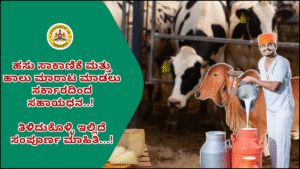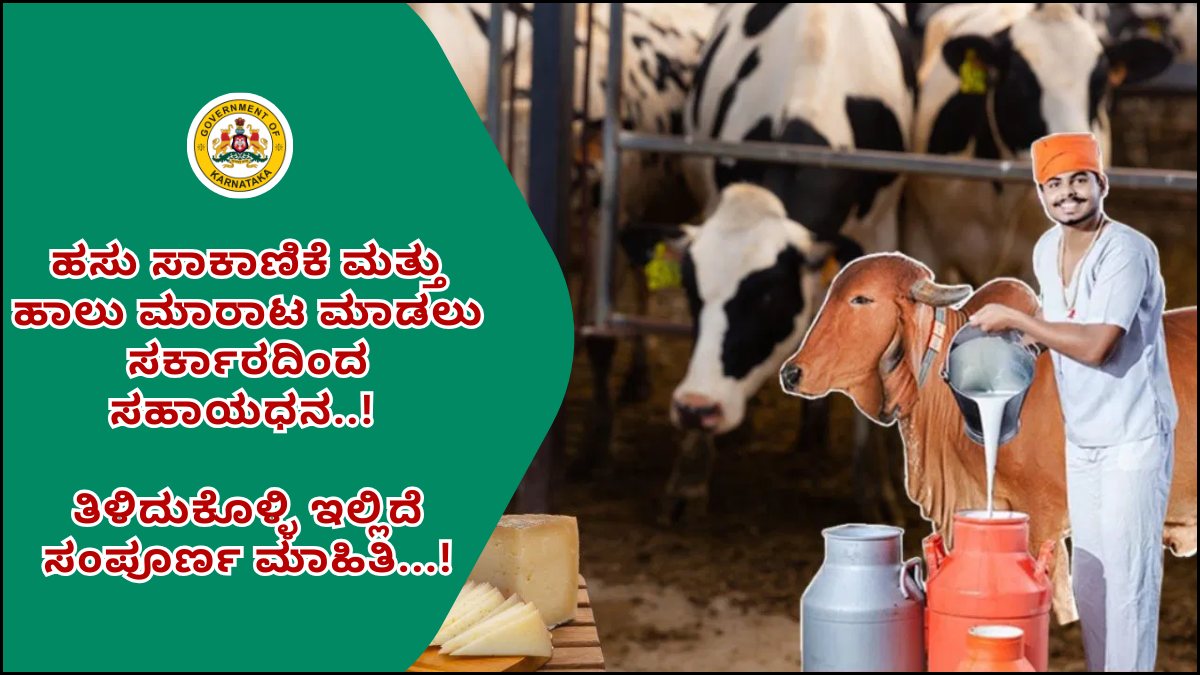India’s dairy sector is one of the largest and most dynamic agricultural ecosystems in the world, contributing significantly to the livelihoods of millions of rural families. Over the years, the government has introduced numerous schemes to promote dairy entrepreneurship, improve milk production, and strengthen the livestock genetic pool. Among these initiatives, one of the most frequently discussed topics in recent years is the “₹2 Crore Subsidy for Dairy Farms.”

While the phrase is widely circulated among dairy enthusiasts and aspiring entrepreneurs, many misunderstand what it truly refers to. Contrary to common belief, this is not a subsidy for setting up a typical dairy farm with milch animals. Instead, it is a high-value capital subsidy tied to a very specific and advanced segment of dairy development: the establishment of Breed Multiplication Farms (BMFs) under the Breed Multiplication Farm Entrepreneurship (BMFE) Scheme, a major component of the Rashtriya Gokul Mission (RGM).
This comprehensive article explains the scheme in detail, its objectives, eligibility criteria, benefits, application process, and its significance in India’s dairy growth. Let’s dive deep into understanding what this ₹2 Crore subsidy really means and who it is meant for.
1. Understanding the Origin of the ₹2 Crore Subsidy
The ₹2 Crore subsidy is part of the Breed Multiplication Farm Entrepreneurship Scheme, introduced by the Department of Animal Husbandry and Dairying (DAHD) under the Rashtriya Gokul Mission. The RGM aims to improve the genetic quality of India’s indigenous cattle and buffalo breeds, increase milk productivity, and modernize the breeding infrastructure in the country.
Within this mission, the BMFE scheme plays a strategic role by encouraging entrepreneurs to establish large-scale, technologically advanced Breed Multiplication Farms capable of producing high-genetic-merit heifers for farmers nationwide.
The government offers:
- 50% capital subsidy on the project cost
- Subject to a maximum limit of ₹2 Crore per entrepreneur
This is where the term “2 Crore Subsidy” originates.
2. Objective of the Breed Multiplication Farm Entrepreneurship Scheme
India faces a major challenge in the availability of:
- High-genetic-merit milch animals
- Disease-free heifers
- Reliable supply of indigenous breed calves
Small farmers often struggle to access quality heifers, leading to lower milk productivity and inefficient breeding cycles.
The scheme aims to solve this problem by creating a network of large-scale farms that function as hubs for genetic improvement.
The key goals include:
a) Enhancing the Genetic Quality of Cattle
By using advanced reproductive technologies, the farm produces more high-quality female calves from elite mothers.
b) Increasing the Availability of Heifers
Thousands of farmers depend on buying young cows and heifers. These farms ensure a steady supply at affordable rates.
c) Modernizing Dairy Breeding Practices
The scheme promotes cutting-edge technologies like:
- Sex-sorted semen
- In-Vitro Fertilization (IVF)
- Embryo Transfer Technology (ETT)
d) Supporting Indigenous Breeds
The scheme focuses especially on native breeds known for disease resistance, adaptability, and long productive life.
3. Why the Subsidy Amount Is as High as ₹2 Crore
Typical dairy farms with 5–50 animals have simpler requirements and smaller capital costs. However, a Breed Multiplication Farm is a large-scale, capital-intensive facility that must meet several demanding criteria.
Here’s why the subsidy ceiling is high:
a) Minimum 200 Elite Animals Required
The project must start with at least 200 milch animals, which increases the initial investment significantly.
b) Use of Advanced Breeding Technologies
Sex-sorted semen machines, IVF labs, and embryo transfer infrastructure require significant capital.
c) Modern Farm Infrastructure
These farms must have:
- Automated sheds
- High-quality feeding and watering systems
- Disease-free housing conditions
- Veterinary and diagnostic facilities
d) National-Level Genetic Improvement Impact
The breed multiplication farm is not a typical dairy farm; it is a genetic resource center meant to serve the entire region.
Due to these requirements, the government supports the project heavily by offering up to ₹2 crore as a capital subsidy, reducing the financial burden on the entrepreneur.
4. Key Mandates and Features of the Scheme
To ensure the farm truly contributes to national breed improvement, the government has made certain guidelines mandatory.
a) Minimum Farm Size: 200 Milch Animals
The entrepreneur must maintain a substantial herd of high-genetic-merit cows or buffaloes.
b) Production of Female Calves for Distribution
The farm must commit to supplying a fixed number of elite female calves/heifers every year to farmers at cost.
c) Adoption of Sex-Sorted Semen
Using sex-sorted semen increases the chances of female calf births up to 90%, ensuring more heifers.
d) Use of IVF and Embryo Transfer Technologies
These technologies dramatically increase the multiplication rate of elite genetic lines.
e) Technical Assistance to Farmers
The farm must provide guidance to nearby farmers on:
- Feeding
- Breeding patterns
- Disease management
- Livestock nutrition
- Modern dairy practices
f) Biosecurity and Disease Prevention Protocols
Since the farm focuses on elite animals, strict biosecurity standards must be met.
5. Eligibility Criteria for the ₹2 Crore Subsidy
The subsidy is not open to everyone. Only entities capable of managing high-technology dairy farms are eligible.
Eligible Applicants Include:
1. Individuals
Experienced individuals with a background in agriculture, dairy, or animal husbandry.
2. Farmer Groups
- Farmer Producer Organizations (FPOs)
- Farmer Cooperatives
- Joint Liability Groups (JLGs)
3. Women’s Groups
Self-Help Groups (SHGs) are also encouraged to apply.
4. Companies
- Section 8 (non-profit) companies
- Start-ups engaged in the dairy/breeding sector
- Dairy entrepreneurs operating under registered entities
Land Requirement
Most project reports require at least 5 acres of owned or leased land.
6. Financial Structure of the BMFE Scheme
The ₹2 Crore subsidy is offered as part of a credit-linked back-ended subsidy model.
This means:
1. The entrepreneur first arranges:
- Their own contribution (usually 10–20%)
- A bank loan for the remaining amount
2. The government then releases the subsidy
Only after the project is inspected and approved.
3. The subsidy goes into a Trust and Retention Account (TRA)
This account is jointly controlled by the bank and the entrepreneur.
4. The subsidy is adjusted toward the bank loan
Reducing the loan liability and making repayment easier.
7. Step-by-Step Application Process
Step 1: Land and Preliminary Planning
Choose a suitable location and prepare a blueprint for the farm layout.
Step 2: Preparation of Detailed Project Report (DPR)
A comprehensive DPR is mandatory and must include:
- Technical design
- Animal procurement plan
- Infrastructure details
- Financial projections
Step 3: Application Submission
Applications are usually invited through Expression of Interest (EOI) notifications. Submission is done through:
- Official DAHD portals
- NDDB-managed portals
- State Animal Husbandry Departments
Step 4: Project Appraisal by Bank
Banks verify the viability and sanction the loan.
Step 5: Technical Evaluation
Government-appointed committees inspect the site and proposed setup.
Step 6: Implementation of the Farm
Construction and infrastructure are developed using:
- Own funds
- Bank loan
Step 7: Subsidy Release
Once the farm is operational, the 50% subsidy (capped at ₹2 Crore) is released.
8. How the Scheme Benefits India’s Dairy Sector
The scheme plays a transformative role in the dairy ecosystem.
a) Faster Genetic Improvement
IVF and sex-sorted semen accelerate breed improvement by producing more high-quality female calves.
b) Higher Milk Productivity
Better genetics lead to healthier animals with higher lactation yields.
c) Economic Support for Small Farmers
Farmers gain access to elite heifers at reasonable costs.
d) Reduced Dependence on Imports
High-genetic-merit animals often had to be imported earlier. This scheme develops local breeding hubs.
e) Boost to Rural Entrepreneurship
Farmers, cooperatives, and young entrepreneurs can take up this challenging but rewarding business.
9. Comparison with Other Dairy Subsidy Schemes
There is often confusion between the ₹2 Crore subsidy and other dairy schemes. It is important to differentiate them.
| Scheme | Purpose | Benefit |
|---|---|---|
| BMFE (RGM) | Breed Multiplication Farms | 50% subsidy up to ₹2 Crore |
| AHIDF | Dairy infrastructure, processing plants | 3% interest subvention & credit guarantee |
| NPDD | Strengthening dairy cooperatives | Grants for chilling & processing |
| Earlier DEDS | Small dairy units | Small subsidies (₹15K to ₹60K range) |
The ₹2 Crore subsidy is exclusive to BMFE and is not available under other schemes.
10. Challenges for Entrepreneurs
While the subsidy amount is attractive, setting up a Breed Multiplication Farm requires:
- High technical knowledge
- Large land area
- Skilled manpower
- Access to veterinary care
- Strong market connections
It is not suitable for beginners in dairy farming.
11. Conclusion
The “₹2 Crore Subsidy for Dairy Farms” refers specifically to the 50% capital subsidy (up to ₹2 Crore) available under the Breed Multiplication Farm Entrepreneurship Scheme of the Rashtriya Gokul Mission.
This is not a subsidy for traditional dairy farms but a highly specialized program encouraging the establishment of advanced breeding centers equipped with technologies like:
- Sex-sorted semen
- IVF
- Embryo Transfer
These farms significantly contribute to improving the genetic quality of livestock in India, boosting milk production, and supporting millions of dairy farmers with better-quality animals.
For experienced dairy entrepreneurs, this scheme offers a remarkable opportunity to participate in nation-building while establishing a profitable and technologically forward enterprise.











